Comprehensive Report: Biorhythm Theory, Mathematical Cycles Analysis
VerifiedAdded on 2023/03/30
|6
|893
|286
Report
AI Summary
This report delves into the subject of biorhythms, exploring the non-scientific techniques used to predict various aspects of a person's life through mathematical cycles. The analysis covers the history of biorhythm theory, its rise in popularity, and the controversies surrounding its validity as a pseudoscience. It explains the three basic biorhythm cycles—physical, emotional, and intellectual—modeled as sine waves, and discusses the concept of critical days. The report also touches on relationships between cycles and the calculation methods used in biorhythm analysis, including a pseudocode and a formula for determining the day of the week for a given date. A biorhythm calculator was developed, and the resulting plots, including a secondary 'Passion' cycle, are presented. The report concludes by acknowledging the ongoing debates and the classification of biorhythms as pseudoscience, while also emphasizing the core argument that life is regulated by natural rhythmic biological cycles.

Biorhythm
[Name]
[Institution]
[Name]
[Institution]
Paraphrase This Document
Need a fresh take? Get an instant paraphrase of this document with our AI Paraphraser
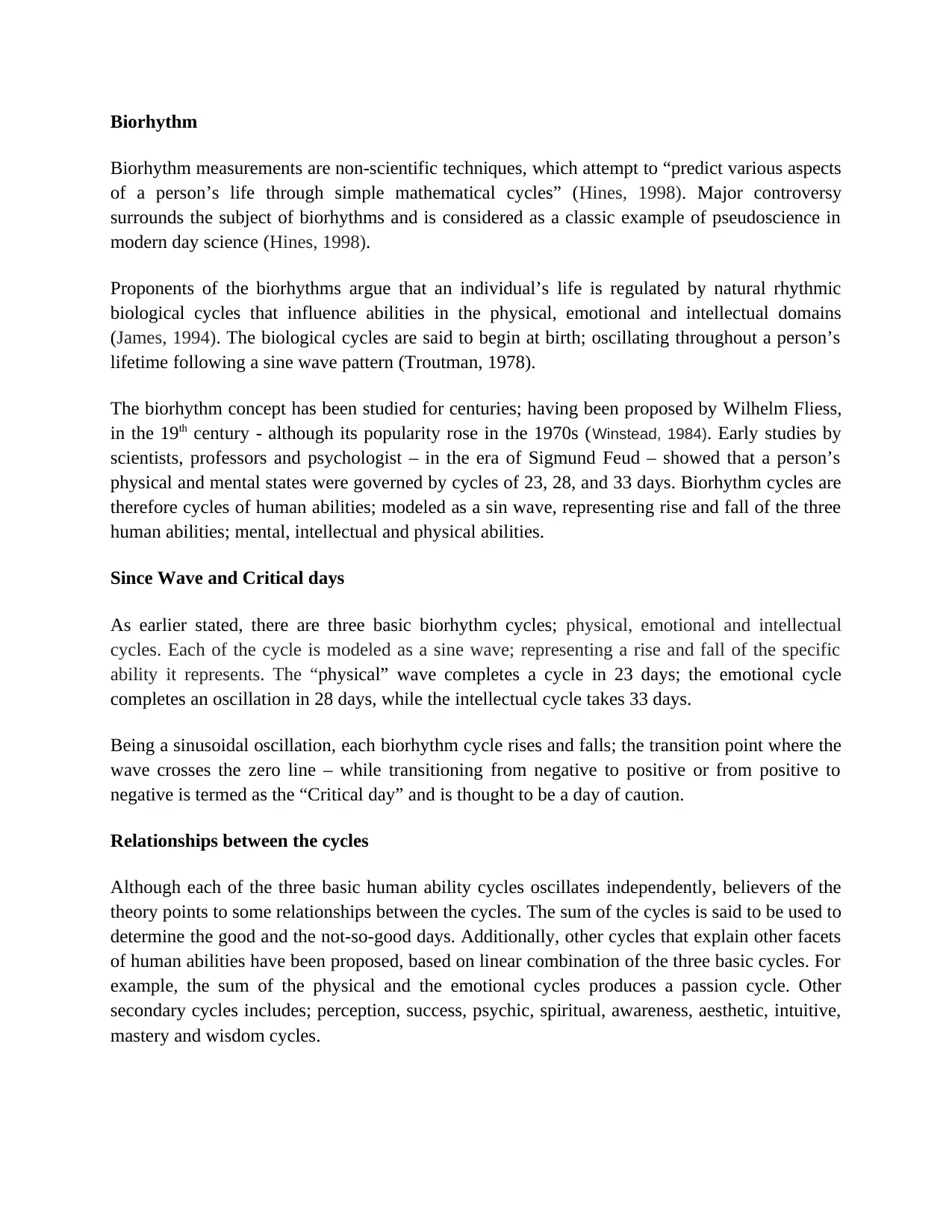
Biorhythm
Biorhythm measurements are non-scientific techniques, which attempt to “predict various aspects
of a person’s life through simple mathematical cycles” (Hines, 1998). Major controversy
surrounds the subject of biorhythms and is considered as a classic example of pseudoscience in
modern day science (Hines, 1998).
Proponents of the biorhythms argue that an individual’s life is regulated by natural rhythmic
biological cycles that influence abilities in the physical, emotional and intellectual domains
(James, 1994). The biological cycles are said to begin at birth; oscillating throughout a person’s
lifetime following a sine wave pattern (Troutman, 1978).
The biorhythm concept has been studied for centuries; having been proposed by Wilhelm Fliess,
in the 19th century - although its popularity rose in the 1970s (Winstead, 1984). Early studies by
scientists, professors and psychologist – in the era of Sigmund Feud – showed that a person’s
physical and mental states were governed by cycles of 23, 28, and 33 days. Biorhythm cycles are
therefore cycles of human abilities; modeled as a sin wave, representing rise and fall of the three
human abilities; mental, intellectual and physical abilities.
Since Wave and Critical days
As earlier stated, there are three basic biorhythm cycles; physical, emotional and intellectual
cycles. Each of the cycle is modeled as a sine wave; representing a rise and fall of the specific
ability it represents. The “physical” wave completes a cycle in 23 days; the emotional cycle
completes an oscillation in 28 days, while the intellectual cycle takes 33 days.
Being a sinusoidal oscillation, each biorhythm cycle rises and falls; the transition point where the
wave crosses the zero line – while transitioning from negative to positive or from positive to
negative is termed as the “Critical day” and is thought to be a day of caution.
Relationships between the cycles
Although each of the three basic human ability cycles oscillates independently, believers of the
theory points to some relationships between the cycles. The sum of the cycles is said to be used to
determine the good and the not-so-good days. Additionally, other cycles that explain other facets
of human abilities have been proposed, based on linear combination of the three basic cycles. For
example, the sum of the physical and the emotional cycles produces a passion cycle. Other
secondary cycles includes; perception, success, psychic, spiritual, awareness, aesthetic, intuitive,
mastery and wisdom cycles.
Biorhythm measurements are non-scientific techniques, which attempt to “predict various aspects
of a person’s life through simple mathematical cycles” (Hines, 1998). Major controversy
surrounds the subject of biorhythms and is considered as a classic example of pseudoscience in
modern day science (Hines, 1998).
Proponents of the biorhythms argue that an individual’s life is regulated by natural rhythmic
biological cycles that influence abilities in the physical, emotional and intellectual domains
(James, 1994). The biological cycles are said to begin at birth; oscillating throughout a person’s
lifetime following a sine wave pattern (Troutman, 1978).
The biorhythm concept has been studied for centuries; having been proposed by Wilhelm Fliess,
in the 19th century - although its popularity rose in the 1970s (Winstead, 1984). Early studies by
scientists, professors and psychologist – in the era of Sigmund Feud – showed that a person’s
physical and mental states were governed by cycles of 23, 28, and 33 days. Biorhythm cycles are
therefore cycles of human abilities; modeled as a sin wave, representing rise and fall of the three
human abilities; mental, intellectual and physical abilities.
Since Wave and Critical days
As earlier stated, there are three basic biorhythm cycles; physical, emotional and intellectual
cycles. Each of the cycle is modeled as a sine wave; representing a rise and fall of the specific
ability it represents. The “physical” wave completes a cycle in 23 days; the emotional cycle
completes an oscillation in 28 days, while the intellectual cycle takes 33 days.
Being a sinusoidal oscillation, each biorhythm cycle rises and falls; the transition point where the
wave crosses the zero line – while transitioning from negative to positive or from positive to
negative is termed as the “Critical day” and is thought to be a day of caution.
Relationships between the cycles
Although each of the three basic human ability cycles oscillates independently, believers of the
theory points to some relationships between the cycles. The sum of the cycles is said to be used to
determine the good and the not-so-good days. Additionally, other cycles that explain other facets
of human abilities have been proposed, based on linear combination of the three basic cycles. For
example, the sum of the physical and the emotional cycles produces a passion cycle. Other
secondary cycles includes; perception, success, psychic, spiritual, awareness, aesthetic, intuitive,
mastery and wisdom cycles.
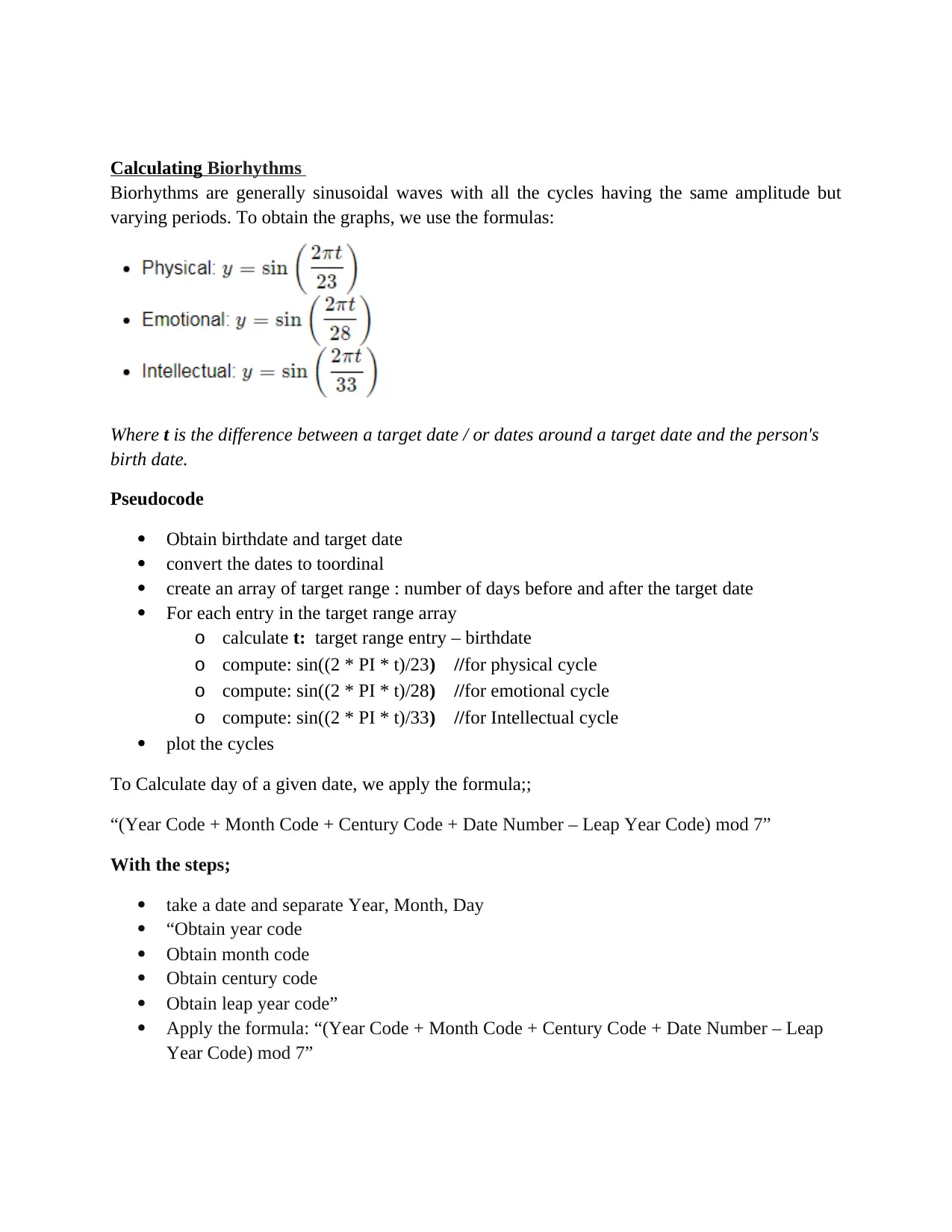
Calculating Biorhythms
Biorhythms are generally sinusoidal waves with all the cycles having the same amplitude but
varying periods. To obtain the graphs, we use the formulas:
Where t is the difference between a target date / or dates around a target date and the person's
birth date.
Pseudocode
Obtain birthdate and target date
convert the dates to toordinal
create an array of target range : number of days before and after the target date
For each entry in the target range array
o calculate t: target range entry – birthdate
o compute: sin((2 * PI * t)/23) //for physical cycle
o compute: sin((2 * PI * t)/28) //for emotional cycle
o compute: sin((2 * PI * t)/33) //for Intellectual cycle
plot the cycles
To Calculate day of a given date, we apply the formula;;
“(Year Code + Month Code + Century Code + Date Number – Leap Year Code) mod 7”
With the steps;
take a date and separate Year, Month, Day
“Obtain year code
Obtain month code
Obtain century code
Obtain leap year code”
Apply the formula: “(Year Code + Month Code + Century Code + Date Number – Leap
Year Code) mod 7”
Biorhythms are generally sinusoidal waves with all the cycles having the same amplitude but
varying periods. To obtain the graphs, we use the formulas:
Where t is the difference between a target date / or dates around a target date and the person's
birth date.
Pseudocode
Obtain birthdate and target date
convert the dates to toordinal
create an array of target range : number of days before and after the target date
For each entry in the target range array
o calculate t: target range entry – birthdate
o compute: sin((2 * PI * t)/23) //for physical cycle
o compute: sin((2 * PI * t)/28) //for emotional cycle
o compute: sin((2 * PI * t)/33) //for Intellectual cycle
plot the cycles
To Calculate day of a given date, we apply the formula;;
“(Year Code + Month Code + Century Code + Date Number – Leap Year Code) mod 7”
With the steps;
take a date and separate Year, Month, Day
“Obtain year code
Obtain month code
Obtain century code
Obtain leap year code”
Apply the formula: “(Year Code + Month Code + Century Code + Date Number – Leap
Year Code) mod 7”
⊘ This is a preview!⊘
Do you want full access?
Subscribe today to unlock all pages.

Trusted by 1+ million students worldwide
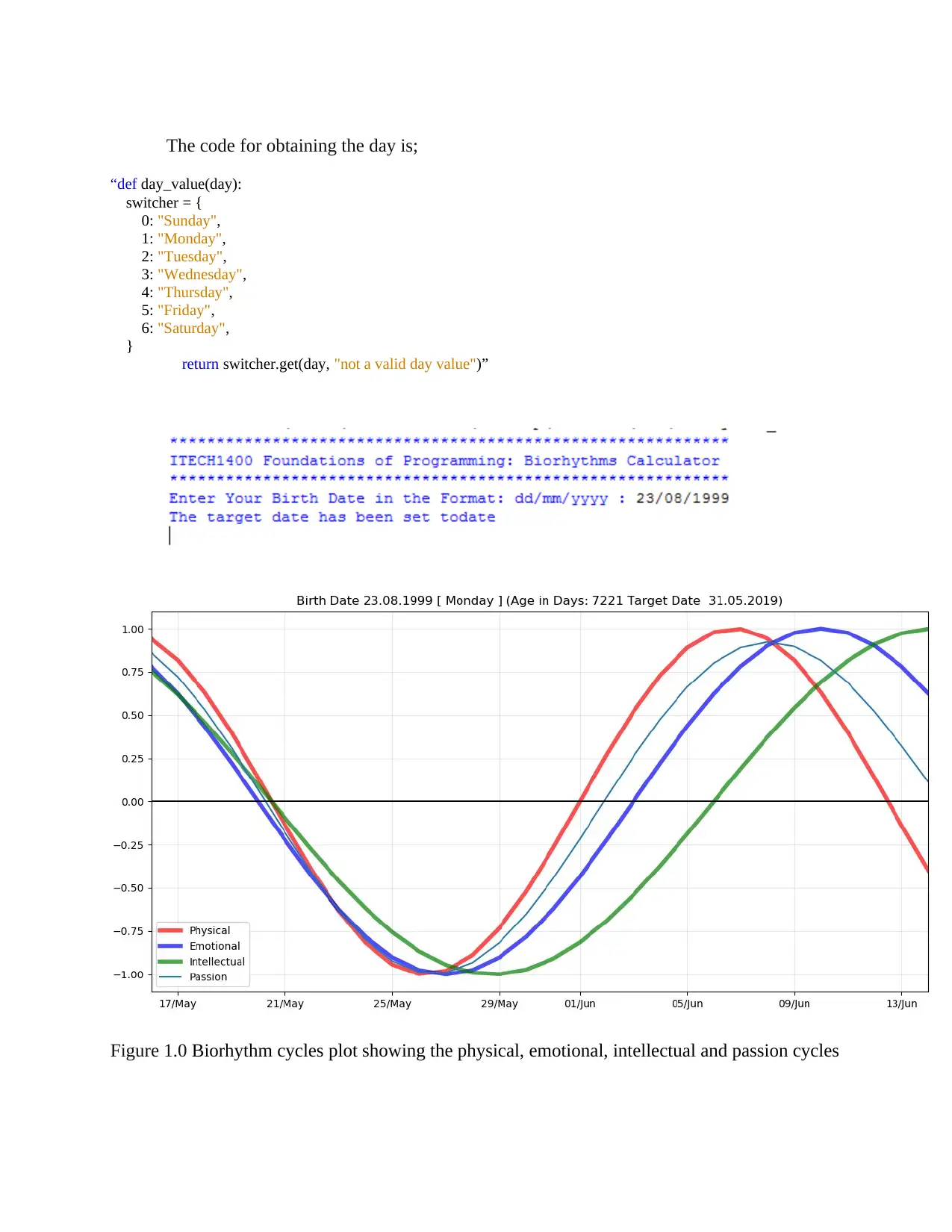
The code for obtaining the day is;
“def day_value(day):
switcher = {
0: "Sunday",
1: "Monday",
2: "Tuesday",
3: "Wednesday",
4: "Thursday",
5: "Friday",
6: "Saturday",
}
return switcher.get(day, "not a valid day value")”
Figure 1.0 Biorhythm cycles plot showing the physical, emotional, intellectual and passion cycles
“def day_value(day):
switcher = {
0: "Sunday",
1: "Monday",
2: "Tuesday",
3: "Wednesday",
4: "Thursday",
5: "Friday",
6: "Saturday",
}
return switcher.get(day, "not a valid day value")”
Figure 1.0 Biorhythm cycles plot showing the physical, emotional, intellectual and passion cycles
Paraphrase This Document
Need a fresh take? Get an instant paraphrase of this document with our AI Paraphraser
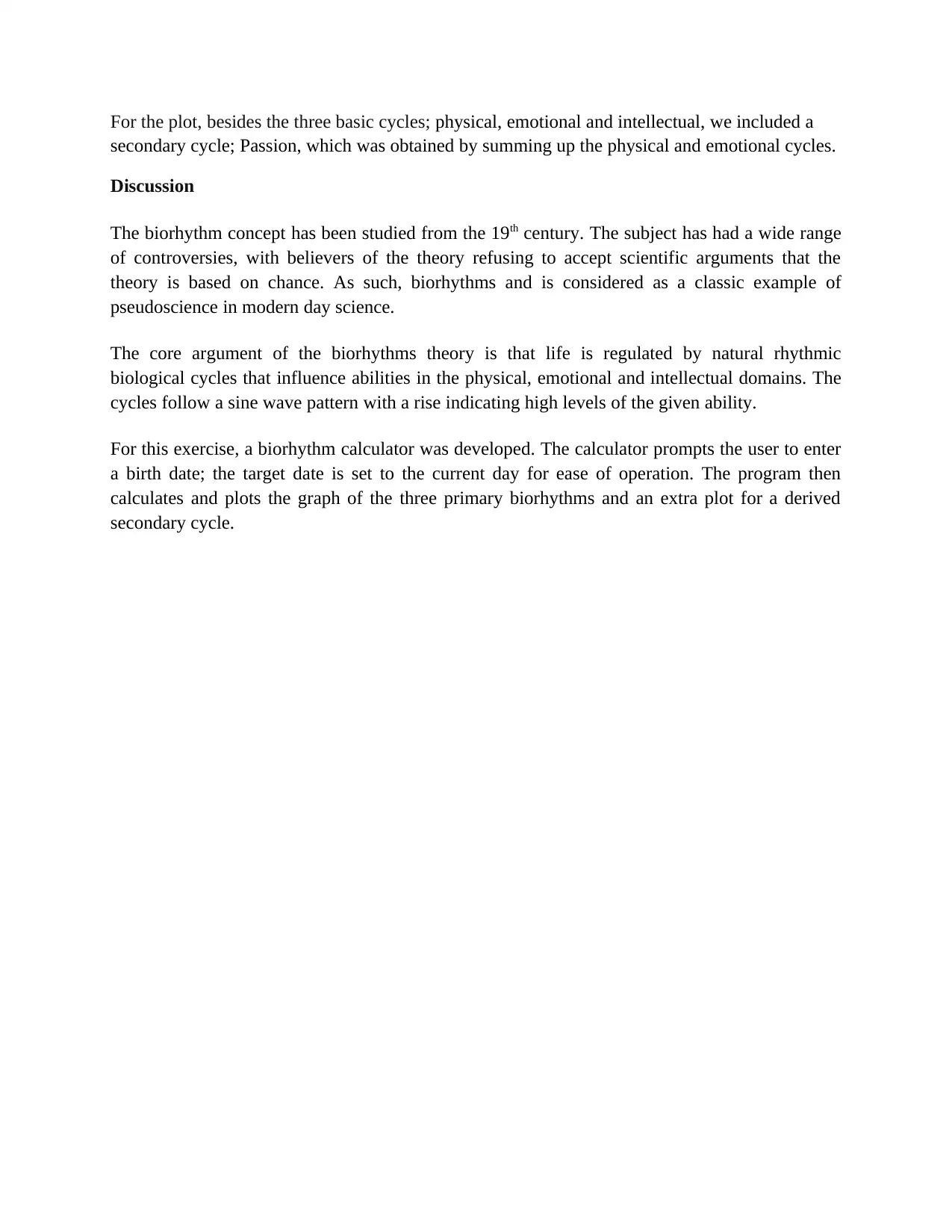
For the plot, besides the three basic cycles; physical, emotional and intellectual, we included a
secondary cycle; Passion, which was obtained by summing up the physical and emotional cycles.
Discussion
The biorhythm concept has been studied from the 19th century. The subject has had a wide range
of controversies, with believers of the theory refusing to accept scientific arguments that the
theory is based on chance. As such, biorhythms and is considered as a classic example of
pseudoscience in modern day science.
The core argument of the biorhythms theory is that life is regulated by natural rhythmic
biological cycles that influence abilities in the physical, emotional and intellectual domains. The
cycles follow a sine wave pattern with a rise indicating high levels of the given ability.
For this exercise, a biorhythm calculator was developed. The calculator prompts the user to enter
a birth date; the target date is set to the current day for ease of operation. The program then
calculates and plots the graph of the three primary biorhythms and an extra plot for a derived
secondary cycle.
secondary cycle; Passion, which was obtained by summing up the physical and emotional cycles.
Discussion
The biorhythm concept has been studied from the 19th century. The subject has had a wide range
of controversies, with believers of the theory refusing to accept scientific arguments that the
theory is based on chance. As such, biorhythms and is considered as a classic example of
pseudoscience in modern day science.
The core argument of the biorhythms theory is that life is regulated by natural rhythmic
biological cycles that influence abilities in the physical, emotional and intellectual domains. The
cycles follow a sine wave pattern with a rise indicating high levels of the given ability.
For this exercise, a biorhythm calculator was developed. The calculator prompts the user to enter
a birth date; the target date is set to the current day for ease of operation. The program then
calculates and plots the graph of the three primary biorhythms and an extra plot for a derived
secondary cycle.
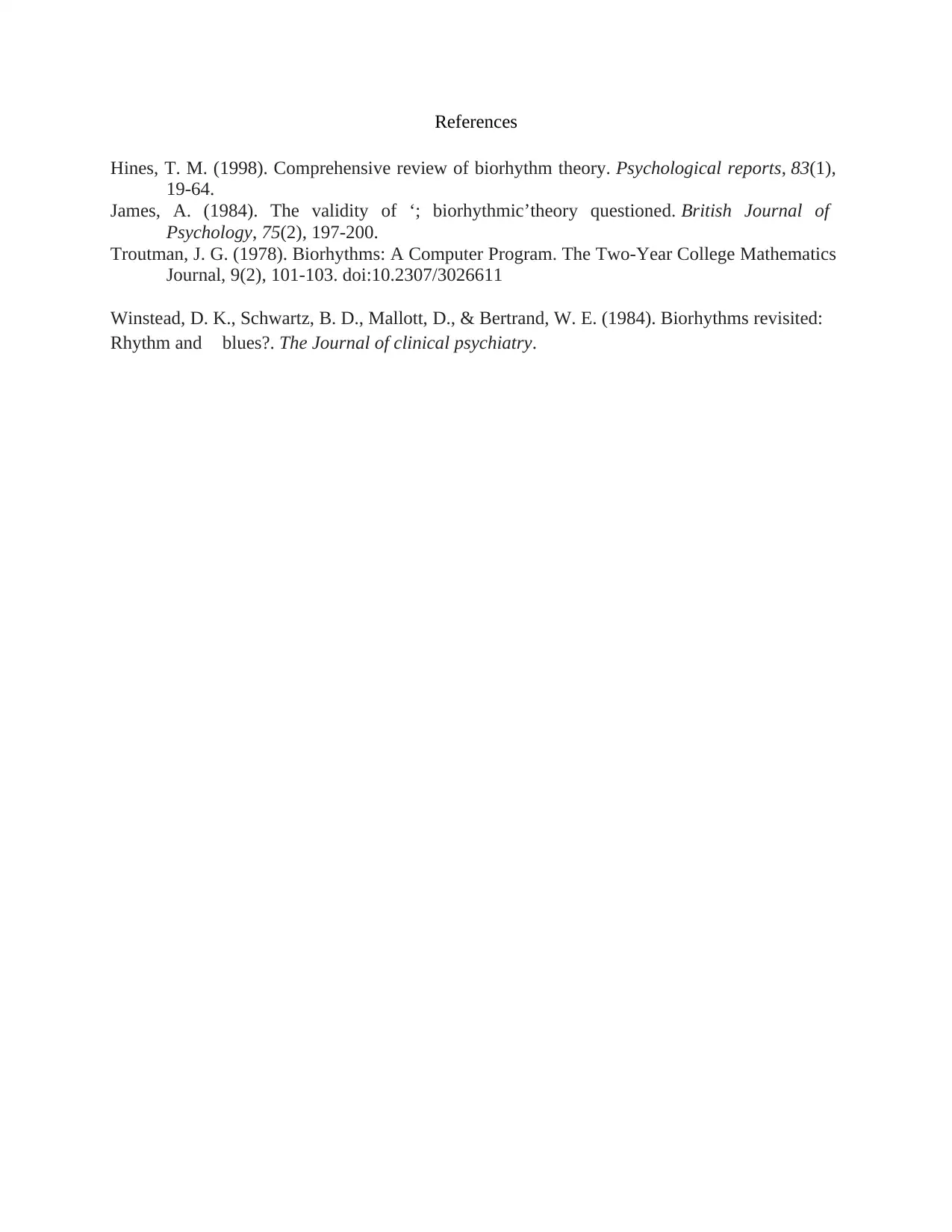
References
Hines, T. M. (1998). Comprehensive review of biorhythm theory. Psychological reports, 83(1),
19-64.
James, A. (1984). The validity of ‘; biorhythmic’theory questioned. British Journal of
Psychology, 75(2), 197-200.
Troutman, J. G. (1978). Biorhythms: A Computer Program. The Two-Year College Mathematics
Journal, 9(2), 101-103. doi:10.2307/3026611
Winstead, D. K., Schwartz, B. D., Mallott, D., & Bertrand, W. E. (1984). Biorhythms revisited:
Rhythm and blues?. The Journal of clinical psychiatry.
Hines, T. M. (1998). Comprehensive review of biorhythm theory. Psychological reports, 83(1),
19-64.
James, A. (1984). The validity of ‘; biorhythmic’theory questioned. British Journal of
Psychology, 75(2), 197-200.
Troutman, J. G. (1978). Biorhythms: A Computer Program. The Two-Year College Mathematics
Journal, 9(2), 101-103. doi:10.2307/3026611
Winstead, D. K., Schwartz, B. D., Mallott, D., & Bertrand, W. E. (1984). Biorhythms revisited:
Rhythm and blues?. The Journal of clinical psychiatry.
⊘ This is a preview!⊘
Do you want full access?
Subscribe today to unlock all pages.

Trusted by 1+ million students worldwide
1 out of 6
Related Documents
Your All-in-One AI-Powered Toolkit for Academic Success.
+13062052269
info@desklib.com
Available 24*7 on WhatsApp / Email
![[object Object]](/_next/static/media/star-bottom.7253800d.svg)
Unlock your academic potential
Copyright © 2020–2025 A2Z Services. All Rights Reserved. Developed and managed by ZUCOL.


